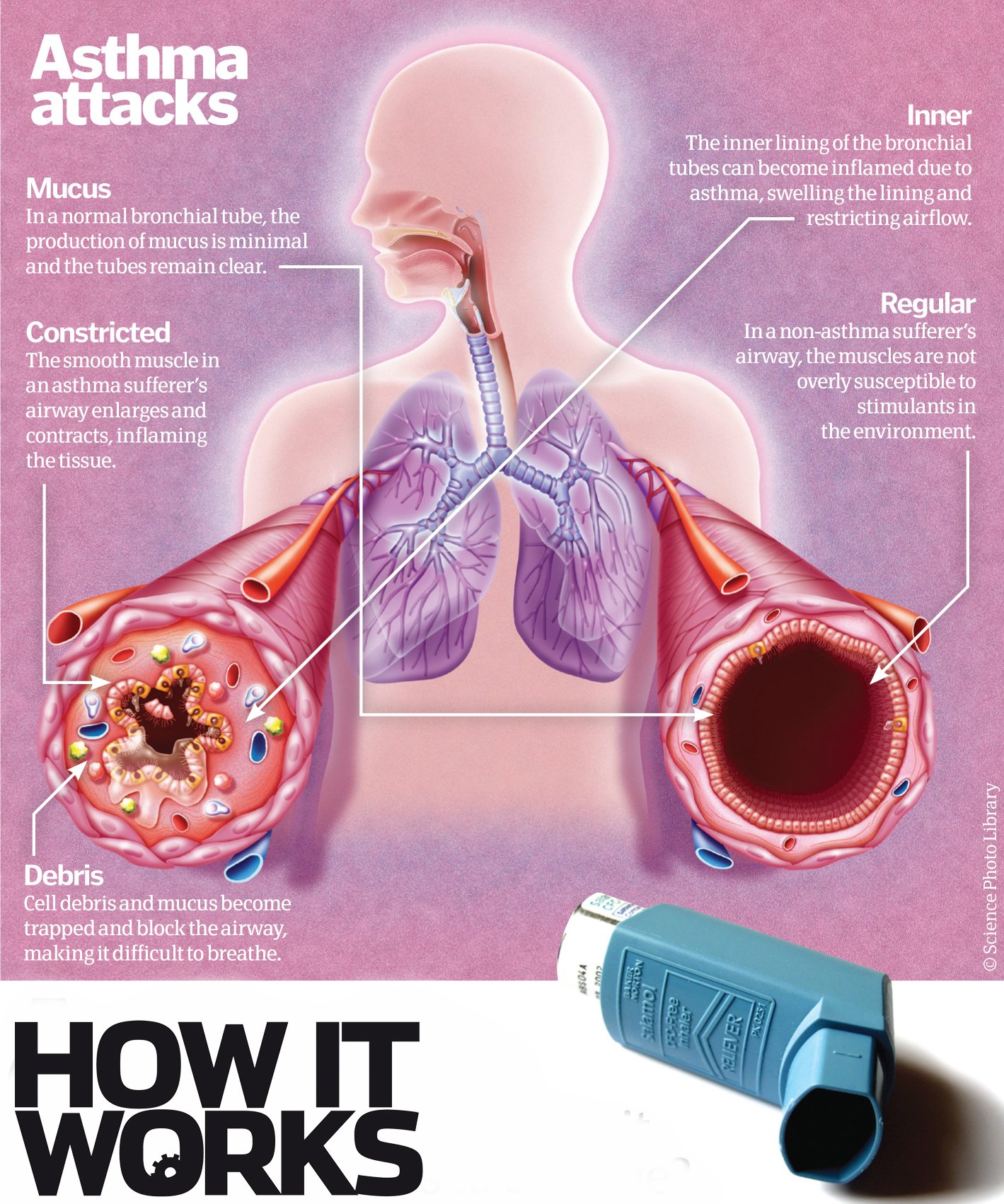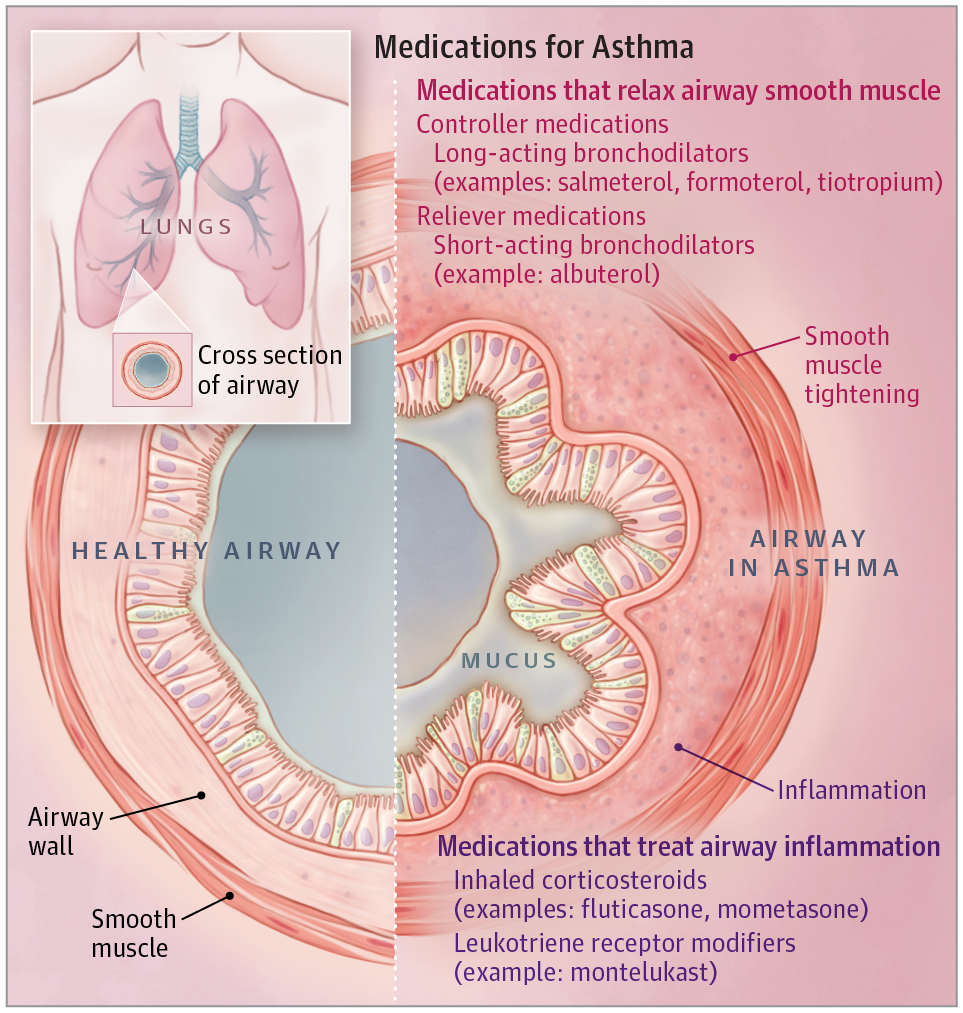How To Use Your Accuhaler
To get the most benefit, it is important to use the correct technique. Ask your doctor, pharmacist, or nurse to explain how to use your accuhaler. Here is some guidance:
Using your accuhaler
- Open: hold the accuhaler in one hand, and with the thumb of the other hand push the thumb grip away from you until you hear a click. This reveals the mouth piece.
- Load the dose: hold the inhaler in a horizontal position. Slide the lever away from you until you hear a click.
- Breath out: breathe out, away from the accuhaler. Do not blow directly into your device.
- Inhale your dose: place the mouth piece in your mouth and form a seal with your lips. Breathe in deeply and forcefully through your mouth. Remove the accuhaler and hold your breath for up to 10 seconds. If you need another dose, wait for 30 seconds and then repeat the process
- Close: the inhaler by sliding the thumb grip towards you.
Cleaning and storing your accuhaler: wipe the mouthpiece with a clean dry tissue. Do not wash the mouthpiece or allow it to get wet when cleaning.;Close the device when not in use.;When to start a new accuhaler: there is a window;on the side;of the;accuhaler called a dose counter. When it turns red it is time to get a new accuhaler.
Is Your Asthma Well Controlled
If your asthma is poorly controlled your healthcare professional will probably put you on a controller medication. You have good asthma control if you:
- Do not have any breathing difficulties, cough or wheeze most days
- Sleep through the night without wakening with cough, wheeze or chest tightness
- Can exercise without cough, wheeze or chest tightness
- Do not miss work or school because of asthma
- Have a normal ;breathing test
- Do not need your reliever inhaler 4 or more times a week
You can check to see if you are over-relying on your reliever inhaler by taking this quiz: How Much is Too Much
Asthma Holding Chamber Or Spacer
A valved holding chamber is a handheld device that attaches to a metered-dose inhaler and captures the medicated mist as it sprays out. The medication is trapped long enough inside the holding chamber to be inhaled at your own speed. It also pulls out large particles of medication and prevents them from settling in your mouth or throat.
A spacer is similar to a valved holding chamber, but it does not suspend the medication, so when using it you must coordinate your breath to begin slightly before actuating the MDI.
Holding chambers are available for use with and without masks. Masks are often essential for children, the elderly or disabled people who cannot close their lips securely around the mouthpiece or who need to take several breaths to inhale the medication fully.
How to use a spacer or holding chamber
You May Like: Diclofenac And Asthma
How Does Dupixent Work For Asthma
How Dupixent works in asthma is not completely understood; however, it is believed to reduce inflammation by reducing the overactive signaling of interleukin-4 and interleukin-13 , two key proteins that contribute to the inflammation that may cause moderate-to-severe asthma. This reduces the release of other inflammatory substances, such as proinflammatory cytokines, chemokines, nitric oxide, eotaxin-3 , and IgE.
- Dupixent 06/2020 sanofi-aventis U.S. LLC
- Dupixent Dupixent.com Sanofi
How Do Prednisone And Systemic Steroids Work To Increase Asthma Control

Using systemic steroids such as methylprednisolone, prednisone, and prednisolone helps to treat severe asthma episodes, allowing people to gain better asthma control. Prednisone and other steroid drugs may be used to help control sudden and severe asthma attacks or in rare cases to treat long-term, hard-to-control asthma.
Most often, prednisone or another steroid is taken in high doses for a few days for more a severe asthma attack.
Side effects of systemic steroids can include weakness, acne, weight gain, mood or behavior changes, upset stomach, bone loss, eye changes, and slowing of growth. These side effects rarely occur with short-term use, such as for an acute asthma attack.
For in-depth information, see WebMD’s article on Prednisone and Asthma.
Recommended Reading: Sickness Induced Asthma
How To Use An Inhaler With A Spacer And Mouthpiece
Learning how to properly use an inhaler with a spacer and mouthpiece for asthma ensures the medicine gets deposited into the lungs. Incorrect technique can leave some of the particles from the medicine on your tongue or throat, where it is useless. Inhalers spray the medicine out so that you can breathe it deep into the lungs. A spacer, or holding chamber, is an attachment that should always be used with your inhaler. The spacer holds the medicine in place so you can breathe it in easier. If you have any further questions about inhalers, spacers or mouthpieces contact your doctors office, asthma care team or pharmacy.
What Are Additional Measures In The Management Of Asthma
Also Check: How To Take Care Of Asthma Without An Inhaler
Types Of Inhaler Device
As if treatment with relievers and preventers weren’t complicated enough, there are different devices to deliver the medicine into your lungs, and sometimes the same medicine comes in several different devices. Some devices involve pressing down and breathing in at the same time.
These are called ‘metered dose inhalers’ and are among the most common type of inhaler used to deliver reliever medication in particular. Sometimes with these metered dose inhalers, your doctor or nurse will recommend that you pump a dose of medicine into a plastic bubble and breathe it in from here.
Others still are ‘breath-actuated’ – as you breathe in, the medicine is delivered automatically into your lungs. Fortunately your practice nurse or GP can help you find the right one for you.
Even if you’ve had asthma or COPD for a long time and have used the same inhaler for years, it’s still worth reminding yourself regularly how they work. You might be surprised how different the ‘optimal’ inhaler technique is from your own!
How Do These Medicines Work Together
Quick-relief medicines are important during a flare-up because they help you breathe more easily right away. If your doctor has prescribed quick-relief medicine, you should always have it with you at school, on the basketball court, at the mall, and even on vacation.
But quick-relief medicines wear off quickly. And they don’t do anything to help prevent a flare-up from happening in the first place. That’s where long-term control medicine comes in. You might not notice long-term control medicine doing anything, but it’s working behind the scenes to keep you from getting asthma flare-ups.
As the name suggests, long-term control medicine is;important for controlling asthma on a regular basis. If your doctor thinks you’re needing quick-relief medicine too often, he or she might also prescribe long-term control medicine.
Some people with mild asthma use only quick-relief medicines. Most people who have more severe asthma have to take long-term control;medicine every day, as well as use quick-relief medicine when they have asthma symptoms. Your doctor will decide what type of medicine you need and how often you need to take it.
Also Check: Does Qvar Make You Gain Weight
What Are Common Types Of Asthma Medications
There are four basic types of asthma medications that each treat a different part of your asthma:
- bronchodilators relax and open the airways to relieve asthma symptoms such as coughing, wheezing, chest tightness and shortness of breath
- anti-inflammatory medications reduce and prevent lung inflammation
- combination medications combine a bronchodilator and anti-inflammatory in one device
- leukotriene modifiers block the action of leukotrienes, chemicals involved in immune system responses
- biologics are medications that target the specific cells and pathways that cause inflammation related to severe asthma.
How Does A Rescue Inhaler Work
A rescue inhaler works by striking at the core of the problem. Since an asthma crisis involves the sudden constriction of the airways, a rescue inhaler assists in relaxing the airways.
A typical rescue inhaler.
Inhalers have different sorts of medications in them, all of which work in relaxing the airways. The most popular inhaler prescribed for quick and short-term relief is the type that contains a drug called albuterol.
Albuterol binds to receptors on the surface of the smooth muscle cells that line the airways, which, in turn, relaxes the muscle. As a result, the airways become less constricted,;allowing the patient to breathe normally again.
Inhalers can come in two types: sold and aerosol, both of;which directly target the airways and lungs. Aerosol inhalers have a liquid that contains gases dissolved under pressure. When the inhaler is squeezed, it releases millions of tiny droplets;that are inhaled and subsequently absorbed by the mucous membrane and bloodstream. If the inhaler contains albuterol, it dilates the airways.
A metered dose inhaler is the most common type of aerosol inhaler. This is the type you have most likely seen asthma patients carrying around on their person.
A closeup of the release of aerosol particles of an MDI.
Related ArticlesRelated Articles
Solid inhalers contain drugs in powdered form. Dry Powder Inhalers , as they are usually called, release a device-measured or metered dose of powdered medication that is inhaled through a DPI device.
You May Like: Join Military With Asthma
How Does Asthma Medication Work
The first step towards asthma care is to know and avoid your asthma triggers. If avoidance doesnt work, you may need asthma medicine;to help control your symptoms. ;
Asthma is a long-term medical condition that affects the airways of the lungs. The goal of asthma treatment;is to control the lung disease. Good asthma care;will prevent troublesome symptoms such as wheezing, coughing, and shortness of breath. It helps your lungs to function well, let your body maintain normal activity levels, and allow you to sleep the whole night.
Asthma Management
For a good asthma control, treatment with medications is required. The right asthma medication will depend on a variety of factors, including your age, health condition, triggers, and response to the pharmaceutical drugs. The medications help your asthma to keep in under control. Your health care provider can prescribe the medication thats best suits you. Knowing what medications are available on the shelves of medical stores can help you with your healthcare expert to create an action plan . An asthma treatment plan can help you manage your asthma symptoms. Read more about the type of asthma medications available in the pharmaceutical industry, what they are, how they work and are the possible side effects.
Medications for Asthma Control
Inhalers
Quick-relief medications or quick-relief bronchodilators
Also Read:;Quick-Relief Asthma Medications
Types Of Medicines Usually Prescribed For Asthma

Bronchodilators
Bronchodilators relax the muscles around the airways . When the airways are more open, it is easier to breathe. There are two general types of bronchodilators, and you may be prescribed one or both types:
- Short-Acting bronchodilators work quickly after you take them so that you feel relief from symptoms quickly.
- Long-Acting bronchodilators have effects that last a long time. They should not be used for quick relief. These medications are only recommended for use when combined with an anti-inflammatory asthma medicine .
Anti-Inflammatories
Anti-inflammatory medicines reduce the swelling and mucus production inside the airways. When that inflammation is reduced, it is easier to breathe. These medicines also are called corticosteroids or steroids. Most often, these are inhaled medications and it is important to rinse out your mouth with water immediately after using them to avoid getting thrush, a yeast infection in your throat.
Some corticosteroids come in pill form and usually are used for short periods of time in special circumstances, such as when your symptoms are getting worse.
Combination Medicines
There are a few medicines that combine inhaled bronchodilators and inhaled corticosteroids.
Anticholinergics
Severe Asthma Treatments
Antibiotics
Recommended Reading: Can Qvar Cause Weight Gain
Check List For Good Usage
- Ask a health professional to demonstrate how to use your inhaler and check your technique.
- Make sure the inhaler is not past its expiry date.
- Make sure your inhaler is not empty.
- If you are using a spacer, make sure it is clean visit the Australian Asthma Handbook for recommendations on how to clean a spacer.
Ingredients In An Asthma Inhaler
Asthma is a chronic lung disease characterized by increased mucus production and airway narrowing due to swelling and tightening of the airway muscles.
If you are experiencing serious medical symptoms, seek emergency treatment immediately.
Inhalers are frequently used to manage asthma and treat attacks. They deliver medication directly into the lungs rather than traveling through the bloodstream. Medicines commonly found in inhalers are short-acting beta agonists, anticholinergics, long-acting beta agonists and corticosteroids.
Don’t Miss: Asthma Heat And Humidity
How To Use An Inhaler
Asthma inhalers are hand-held portable devices that deliver medication to the lungs. They must be used properly to help achieve the best control of asthma.
If you are using a puffer, you may benefit from using a spacer a plastic container with a mouthpiece or mask at one end to ensure the asthma medication gets into your lungs.
How To Use Metered
With metered-dose inhalers being the most widely used among all inhaler types, this might be the kind you might be familiar with. Here are the steps to use a metered-dose inhaler:
Step 1: Take off the cap of the inhaler and shake the inhaler well.
Step 2: Hold the inhaler in an upright position and stand up or sit up straight.
Step 3: Exhale and breathe out all the air in your lungs as you tilt your head slightly backwards.
Step 4: Hold the mouthpiece between your teeth, close your lips around to achieve a proper seal.
Step 5: Start breathing in slowly through the mouth and press down the canister fully to release one spray. Continue breathing in slowly and deeply. This coordination is important to follow to ensure the proper dose of the medication is delivered.
Step 6: Remove the inhaler from your mouth.
Step 7: Hold your breath for ten seconds, or as long as you comfortably can, and breathe out slowly.
Also Check: Remedies For Asthma Attack Without Inhaler
Don’t Miss: Stop Asthma Coughing
How Are Inhalers Used To Treat Asthma
Many asthma medications are delivered using an inhaler or a nebulizer. Inhalers and nebulizers are devices that allow the asthma medications to be breathed in and go straight to the airways. There are four types of delivery devices:
- metered-dose inhaler : a pressurized device that releases medication in a fine spray for you to inhale
- slow-moving mist inhaler: similar to an MDI, with a slower-moving mist
- dry powder inhaler : releases medication as a fine powder for inhaling
Visit our online store to download our free respiratory treatment poster or purchase print copies. The respiratory treatment poster is an asthma medication chart that lists asthma inhalers by brand name as well as biologic medications used to treat asthma.
How to Use a Metered Dose Inhaler
How to Use a Slow-Moving Mist Inhaler
If You Have Asthma Your Healthcare Team Will:
- Explain how you can keep your asthma under control by avoiding your personal triggers
- Prescribe medication that will help minimize your symptoms
- Show you how to take your medication properly, checking your inhaler technique
- Work with you so you have a written;Asthma Action Plan
- Recommend that you visit on a regular basis so that your symptoms can be monitored and your treatments adjusted if necessary
Don’t Miss: Can Asthma Symptoms Last For Weeks
Will I Have To Take Medicine All The Time
Maybe not. Asthma is a chronic condition that is controllable. Unfortunately, there is no cure for asthma. For that reason, you may have asthma symptoms when exposed to triggers. This is the case even if you dont have symptoms very often. Your triggers can change over time, and your treatment will depend on two things: how severe your asthma is, and how often you have symptoms. If your asthma is controlled, your treatment will focus on managing symptoms and treatment of episodes when they happen.;
If your symptoms happen at certain times and you know what caused them, you and your doctor can use this information to determine the best treatment. If, for example, you have seasonal asthma because of a specific pollen allergy, you may take medicines only when that pollen is in the air. But asthma that specific is not common. Many people with asthma take some form of medicine most or all of the time.;
Different Types Of Asthma Medications

Many first-line controller and rescue medications are administered through asthma inhalers. Some of these inhalers are called metered-dose inhalers in which the inhaler itself propels the medication into the lungs. Other inhalers are activated by patients taking a breath, and these are called dry powder inhalers or breath-actuated inhalers. Different types of inhalers may work better for different individuals, but both types of inhalers are effective for asthma symptom control if used correctly.
Nebulizers are machines that allow asthma medications to be delivered in an aerosolized form, and the medications are then inhaled through a mouthpiece or mask. Nebulizers are often used for children who are unable to perform the proper technique required for inhalers. Some asthma medications are also available as pills. There are currently two injectable medications for asthma , and these are administered in a health-care setting only. There is also an intravenous medication for asthma . Within the near future, there will likely be additional asthma medications that can be administered either by injection or intravenously.
The cause of asthma is unknown. Physicians know more about the abnormal conditions that occur in asthma. These conditions include:
You May Like: How To Calm Asthma Without Inhaler
